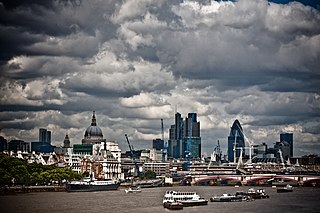
Liquidation is the process in accounting by which a company is brought to an end. The assets and property of the business are redistributed. When a firm has been liquidated, it is sometimes referred to as wound-up or dissolved, although dissolution technically refers to the last stage of liquidation. The process of liquidation also arises when customs, an authority or agency in a country responsible for collecting and safeguarding customs duties, determines the final computation or ascertainment of the duties or drawback accruing on an entry.

In accounting, insolvency is the state of being unable to pay the debts, by a person or company (debtor), at maturity; those in a state of insolvency are said to be insolvent. There are two forms: cash-flow insolvency and balance-sheet insolvency.
An officer of the Insolvency Service of the United Kingdom, an official receiver (OR) is an officer of the court to which they are attached. The OR is answerable to the courts for carrying out the courts' orders and for fulfilling their duties under law. They also act on directions, instructions and guidance from the service's Inspector General or, less often, from the Secretary of State for Business, Energy and Industrial Strategy.
Wrongful trading is a type of civil wrong found in UK insolvency law, under Section 214 Insolvency Act 1986. It was introduced to enable contributions to be obtained for the benefit of creditors from those responsible for mismanagement of the insolvent company. Under Australian insolvency law the equivalent concept is called "insolvent trading".
In law, a liquidator is the officer appointed when a company goes into winding-up or liquidation who has responsibility for collecting in all of the assets under such circumstances of the company and settling all claims against the company before putting the company into dissolution. Liquidator is a person officially appointed to 'liquidate' a company or firm. Their duty is to ascertain and settle the liabilities of a company or a firm. If there are any surplus, then those are distributed to the contributories.
As a legal concept, administration is a procedure under the insolvency laws of a number of common law jurisdictions, similar to bankruptcy in the United States. It functions as a rescue mechanism for insolvent entities and allows them to carry on running their business. The process – in the United Kingdom colloquially called being "under administration" – is an alternative to liquidation or may be a precursor to it. Administration is commenced by an administration order.

United Kingdom insolvency law regulates companies in the United Kingdom which are unable to repay their debts. While UK bankruptcy law concerns the rules for natural persons, the term insolvency is generally used for companies formed under the Companies Act 2006. Insolvency means being unable to pay debts. Since the Cork Report of 1982, the modern policy of UK insolvency law has been to attempt to rescue a company that is in difficulty, to minimise losses and fairly distribute the burdens between the community, employees, creditors and other stakeholders that result from enterprise failure. If a company cannot be saved it is liquidated, meaning that the assets are sold off to repay creditors according to their priority. The main sources of law include the Insolvency Act 1986, the Insolvency Rules 1986, the Company Directors Disqualification Act 1986, the Employment Rights Act 1996 Part XII, the EU Insolvency Regulation, and case law. Numerous other Acts, statutory instruments and cases relating to labour, banking, property and conflicts of laws also shape the subject.

Re Barleycorn Enterprises Ltd [1970] Ch 465 is a UK insolvency law case, concerning the priority of creditors in a company winding up. It was held that fees for liquidation came in priority to preferential claims and floating charges. This was overturned by the House of Lords in Buchler v Talbot, but reinstated by Parliament through an amendment to the Insolvency Act 1986 s 176ZA.

The Winding-up and Restructuring Act is a statute of the Parliament of Canada that provides for the winding up of certain corporations and the restructuring of financial institutions. It was passed in 1985, and has been amended since. Predecessors of the act date back to 1882.

Sinclair v Brougham [1914] AC 398 is an English trusts law case, concerning the right of depositors to recover sums which were deposited to a building society under contracts of deposit which were beyond the powers of the building society.

Buchler v Talbot[2004] UKHL 9 is a UK insolvency law case, concerning the priority of claims in a liquidation. Under English law at the time the expenses of liquidation took priority over the preferred creditors, and the preferred creditors took priority over the claims of the holder of a floating charge. However, a crystallised floating charge theoretically took priority over the liquidation expenses. Accordingly the courts had to try and reconcile the apparent triangular conflict between priorities.

The British Virgin Islands company law is the law that governs businesses registered in the British Virgin Islands. It is primarily codified through the BVI Business Companies Act, 2004, and to a lesser extent by the Insolvency Act, 2003 and by the Securities and Investment Business Act, 2010. The British Virgin Islands has approximately 30 registered companies per head of population, which is likely the highest ratio of any country in the world. Annual company registration fees provide a significant part of Government revenue in the British Virgin Islands, which accounts for the comparative lack of other taxation. This might explain why company law forms a much more prominent part of the law of the British Virgin Islands when compared to countries of similar size.

British Virgin Islands bankruptcy law is principally codified in the Insolvency Act, 2003, and to a lesser degree in the Insolvency Rules, 2005. Most of the emphasis of bankruptcy law in the British Virgin Islands relates to corporate insolvency rather than personal bankruptcy. As an offshore financial centre, the British Virgin Islands has many times more resident companies than citizens, and accordingly the courts spend more time dealing with corporate insolvency and reorganisation.

Cayman Islands company law is primarily codified in the Companies Law and the Limited Liability Companies Law, 2016, and to a lesser extent in the Securities and Investment Business Law. The Cayman Islands is a leading offshore financial centre, and financial services form a significant part of the economy of the Cayman Islands. Accordingly company law forms a much more prominent part of the law of the Cayman Islands than might otherwise be expected.

Cayman Islands bankruptcy law is principally codified in five statutes and statutory instruments:
Australian insolvency law regulates the position of companies which are in financial distress and are unable to pay or provide for all of their debts or other obligations, and matters ancillary to and arising from financial distress. The law in this area is principally governed by the Corporations Act 2001. Under Australian law, the term insolvency is usually used with reference to companies, and bankruptcy is used in relation to individuals. Insolvency law in Australia tries to seek an equitable balance between the competing interests of debtors, creditors and the wider community when debtors are unable to meet their financial obligations. The aim of the legislative provisions is to provide:
Provisional liquidation is a process which exists as part of the corporate insolvency laws of a number of common law jurisdictions whereby after the lodging of a petition for the winding-up of a company by the court, but before the court hears and determines the petition, the court may appoint a liquidator on a "provisional" basis. Unlike a conventional liquidator, a provisional liquidator does not assess claims against the company or try to distribute the company's assets to creditors, as the power to realise the assets comes after the court orders a liquidation.

Hong Kong insolvency law regulates the position of companies which are in financial distress and are unable to pay or provide for all of their debts or other obligations, and matters ancillary to and arising from financial distress. The law in this area is now primarily governed by the Companies Ordinance and the Companies Rules. Prior to 2012 Cap 32 was called the Companies Ordinance, but when the Companies Ordinance came into force in 2014, most of the provisions of Cap 32 were repealed except for the provisions relating to insolvency, which were retained and the statute was renamed to reflect its new principal focus.

Brooks v Armstrong[2016] EWHC 2289 (Ch), [2016] All ER (D) 117 (Nov) is a UK insolvency law case on wrongful trading under section 214 of the Insolvency Act 1986.

Re MC Bacon Ltd [1991] Ch 127 is a UK insolvency law case relating specifically to the recovery the legal costs of the liquidator in relation to an application to set aside a floating charge as an unfair preference.










